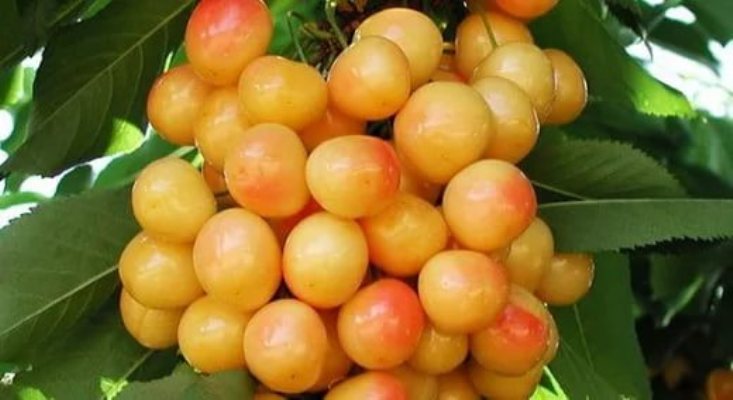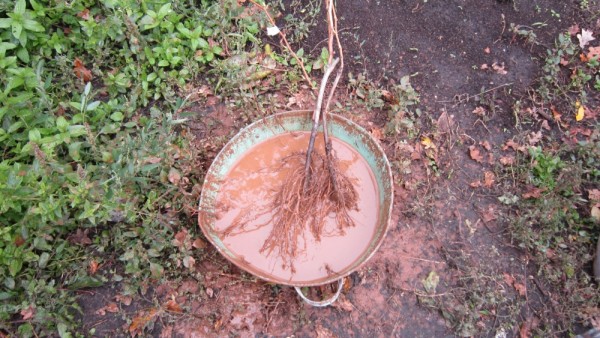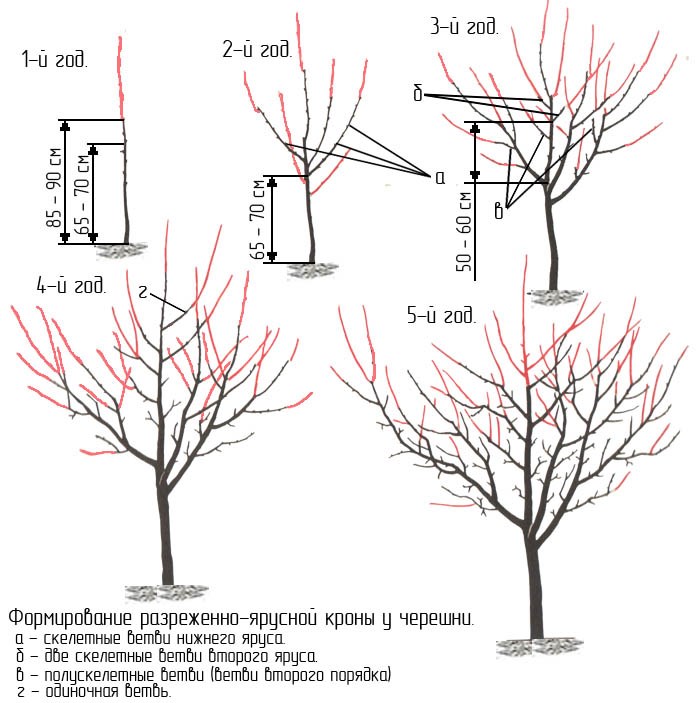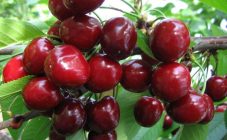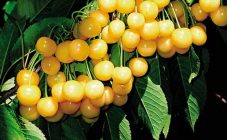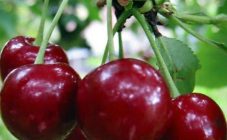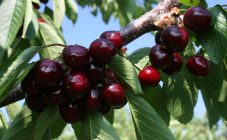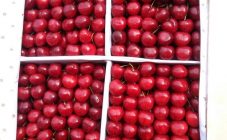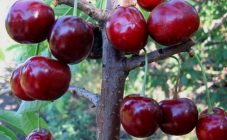Content:
It is very difficult to choose the best varieties of cherries for the garden from a huge variety. The garden cherry of the Priusadebnaya yellow variety is attractive because it gives an early harvest of sweet, golden-colored fruits.
general information
As a garden tree, cherry was used even before our era in gardens in western Asia and Europe. Sweet cherry or bird cherry (lat.Púnus ávium) is a woody plant of the Pink family. Delicious fruits contain ascorbic acid, vitamins B1, B2, A, PP, E, pectin, carotene, malic acid, flavonoids, micro- and macroelements, sugars, coumarin.
Sweet cherry Home garden yellow was obtained by an unusual scientific method. For breeding the variety, the authors B.L. Nikitin, G.G. Nikiforova, I.N. Zolotukhina, L.A. Deineka, working at the All-Russian Research Institute named after Michurin, crossed varieties of sweet cherries Leningradskaya krasnaya and Zolotaya Loshitskaya. Further, the seeds of the new variety were irradiated with particle fluxes and high energy waves, which made it possible to obtain a variety with the required qualities. More than 20 years ago, the variety was zoned for the Chernozem region.
Characteristics and description of the variety of cherries Priusadechnaya yellow
- Early maturing variety. Harvesting is carried out in early June.
- Not fast-growing. Fruiting of the tree begins 6 years after planting in a permanent place.
- High productivity. One adult tree can harvest 85 kg.
- Frost resistance. Household cherries are capable of surviving frosts of -20 degrees. This variety also has a high resistance to return frost in the spring.
- It has a high immunity to fungal viruses and infections.
- Self-fertile. No tree pollinator required.
- The fruits are table varieties. It is useful to eat them fresh. They are great for conservation. Not suitable for long-term transport.
The tree can grow up to 6 meters in height. By the end of the first third of life, it grows by 60%.
The root is horizontal, but under favorable conditions, vertical roots can develop in the first years of life. Spreading, spherical crown grows in tiers. Requires seasonal pruning in spring.
The trunk is massive, brownish brown. Shoots are straight. The buds are conical, brown and small in size. Buds can be generative, vegetative, as well as mixed, can be placed on growth and fruit shoots.
A large oval leaf with tiny jagged edges and a sharp tip. The petiole is medium in size with two glands at the base of the plate. Leaf color is light green.
The garden sweet cherry blossoms in the garden yellow in early spring with large, 3-5 petal inflorescences. The flowers are unisexual, in the center, among the many stamens, the stigma of the pistil rises. The color of the petals is snow-white.
Drupes are small, round in shape. The weight of one fruit is 5-6 grams. The fruit has a thin, leathery, golden-yellow exocarp and a hard intracarp (bone). The stalk and bone are easy to separate from the fruit.
The taste of Home Garden yellow cherries is sweet, with a slight sourness. The juice has no color. On a 5-point scale, taste is rated at 4.7.
Cherry agrotechnology
Sweet cherry is demanding on the planting site.It should be well lit, sunny and protected from strong winds. The amount of sunlight directly affects the sugar content of sweet cherry fruits, as well as the volume of the harvest.
The soil for this variety is loamy or sandy loam. Groundwater should lie no closer than two meters to the soil surface. If the landing site is likely to be flooded, it is necessary to make a drainage system in advance, and even better to transfer the landing. The acidity of the soil should be neutral. Heavy, acidic soils with close groundwater will not allow the tree to develop and bear fruit normally.
A cherry seedling with an open root system can be planted in the ground only in early spring.
Planting in late spring can also be detrimental to the cherry seedling. A significant increase in air temperature and a lack of moisture will affect the formation of the tree.
Planting plants in containers is possible both in spring and autumn.
Planting pit preparation
- In the selected area, remove stones, weeds in advance and dig a hole measuring 70 * 70 cm.
- Leave a distance of 3.5 meters between seedlings. The feeding area of one tree is about 12 sq. meters.
- Lay a drainage layer at the bottom of the pit.
- Mix the excavated soil with fertilizers: organic matter - humus, manure, humus, or a mineral complex of superphosphate (0.2 kg) and potassium chloride (0.4 kg).
- For support, immediately drive a 2 m pole into the bottom of the pit.
- Fill the hole with a mixture of soil and fertilizers and water it abundantly so that the earth settles.
Sapling selection
Grafted healthy seedlings are best purchased from garden centers. When buying, you need to pay attention to the root system. It should be branched, well developed and not dried out. The stem should be even, without damage, with live kidneys. The age of the seedling for planting is 1-2 years.
Landing
It is necessary to remove part of the soil from the pit, spread the roots of the seedling and install it in the middle of the pit. After planting, the root collar should be 5 - 6 cm higher than the ground. Fill the soil back up, carefully tamp and tie the seedling to the support.
Pruning
When buying a seedling, you can cut it right away, leaving a height of up to 1 meter with 4-5 buds, so that the tree forms side shoots and does not grow up.
Proper pruning will help the cherries increase their yield, increase sugar content and fruit size, and help prevent many fungal diseases. If a branch needs to be removed completely, it is cut off without leaving a hemp. With rapid growth in August, healthy young shoots can be shortened by cutting 15 cm each, which will help the branch begin preparing for winter.
To form the crown, the upper shoots must be shortened in time, leaving at least 40 cm in length.
Spring sanitary pruning must be carried out. Branches are cut out, thickening the crown of the tree, dried and broken, as well as growing inside the crown. Young shoots should be left only straight and strong.
In the first year after planting, all flowers that have appeared on the tree must be removed. This will give him the opportunity to spend energy on rooting, and not on fruiting.
From the moment of the beginning of fruiting, experienced gardeners recommend rationing the crop, that is, removing 50% of green ovaries. This will allow the remaining fruit to grow much larger, and the tree itself will bear fruit every year.
Any cherry is prone to the formation of root growth, it must be removed so that the tree does not waste energy on an unnecessary mass of greenery.
Watering
After planting, a young plant is watered more often than an adult tree. The frequency and amount of watering depends on the amount of precipitation. In case of drought, the optimal regime is 4-5 times a month, 2 buckets of water for each tree.
Before the fruits ripen, watering must be reduced so that the crop does not crack. In a dry year, it is imperative to water the cherries before leaving for the winter rest so that the tree is sufficiently saturated with moisture.
Top dressing
The fertilizer applied during planting will be consumed by the tree by the third year of life. Further feeding consists of applying nitrogen-containing fertilizers (urea) in the spring, and fertilizers without nitrogen (superphosphate and potassium sulfate) in the autumn.
Diseases and pests
Sweet cherry varieties Priusadebnaya yellow are resistant to many diseases. But with improper pruning and excessive watering, the tree can become infected with such fungal diseases as phyllostictosis, rust, gray rot, clasterosporium disease, etc. In the spring, for the prevention of diseases, cherries and the trunk circle are treated with a solution of copper sulfate (1%) or nitrafen, the tree trunk is whitewashed.
Advantages and disadvantages
Advantages of the variety of cherries Home Garden yellow:
- Frost resistance.
- Early ripening.
- Bountiful harvest.
- Excellent taste characteristics.
- High immunity.
- Ability to bear fruit without additional pollination.
Disadvantages:
- The height of the tree (6 m) makes it difficult to harvest and care for the crown.
- Takes up a lot of space.
- Fruiting begins at the 6th year of the tree's life.
- The fruits do not tolerate long-distance transportation.
Sweet cherry Home garden yellow - a tree with a bright character. It was bred specifically for cultivation in summer cottages and backyard plots, so that at the beginning of summer it was possible to harvest an early harvest of sweet cherries filled with vitamins.
